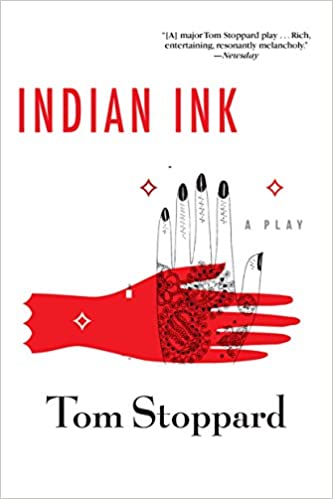According to the Czech-born British playwright, Tom Stoppard in an interview with Mel Gussow in 1995, ‘Indian Ink is actually a very intimate play. It is a play about intimate scenes.’ Indeed, his two act play, originally based on his earlier radio play ‘In the Native State’ evolves on three critical themes to portray powerfully the intense epoch of struggle of India for its freedom from British colonists: cultural imperialism, the Empire and nationalism. In fact, the cultural and holistic approach of the dramatist also hints at a cultural reconciliation of cultures in relation to the Anglo-Indian relationship through the relationship of Nirad Das, an Indian Painter and Flora Crewe, a British poetess who comes to India, aligning the motifs of art and sexuality in their interactions.
It is salient to probe deeper in the life of the Stoppard to better fathom his riveting and didactic writing style in the drama. His father worked as a physician in a shoe company who moved to Singapore. Nevertheless, with the Japanese Invasion, Tom and his elder brother managed to be evacuated and moved to Darjeeling in India. What arouses our pity is how his father who had to stay back in Singapore was killed. Then, in 1946, his mother got married to a British Army officer named Kenneth Stoppard and thus Tom Straussler became Tom Stoppard. Undeniably, this elucidates how Stoppard has grown in a blended cultural lifestyle with both contact with the Indian and British way of living. Aged 17, he left school to work for a newspaper called Western Daily Press. Further to that, his play ‘Rosencrantz and Guildenstern Are Dead’ triggered international acclaim for his image as a writer and thereby, he started to be considered the most performed playwright of his generation.
Interestingly, the inspiration to write ‘Indian Ink’ was brewed from the intention of writing in the form of a dialogue between a painter and a poet. Through Flora Crewe and Nirad Das, we get a clear insight on the complicated political context in which India was in, on the Theosophical society and also on the differences of cultures between the two. Needless to stress on how the sexually charged poem and the sexual openness of Flora is juxtaposed with the shy and non-sexualised character of Nirad Das. Coupled to that, her attempt to portray the ‘heat’ of India and of lust in her poem denotes dramatically her ease with the theme of sexuality and eroticism while it remains more a taboo in India. Besides, what is admirable is how they try to draw each other closer to their own culture and Flora infuses the theme of nationalism in Nirad Das, depicting how art is not only related to one’s culture or origin. No doubt the reference to the Theosophical society evokes a sense of nationalism as it incites Indians to be more proud of their history. When Flora tells Das that ‘’ it is your country’’, she is trying to awaken the spirit of nationalism in Nirad Das. Evidently, the nude portrait painted by Nirad Das for Flora Crewe connotes a lurk of hope since both as representatives of their distinct cultures of colonised and colonisers, are united in Art and are promoting a more equal and compromised relationship.
Added to that, the use of a second setting in time and place other than in India in the 1930 helped us to comprehend the historical and social progress made between the British imperialists and the Indian nationalists. Interestingly, in England in the 1980s, the characterisation of Anish Das, the son of Nirad Das, upon discussing Mrs Swan, Flora’s sister, is indicative of higher cultural tolerance and cultural amalgam with his symbolic mixed marriage and settlement in India. The beauty of the play can be traced in how ‘’Anish has repeated his father’s aesthetic embrace of Flora and has taken it further-to a more literal level.’
On the same line, the beguiling play also describes how academic history, which always claims to be objective, is in reality flawed by human interpretation through the characterisation of the scholar Eldon Pike, obsessed with the analysis of the past through scraps of evidence on paper. What is evident is how the duality of loss and recovery remains at the heart of human exploration. The reconstruction of Flora’s life, past and encounters is embedded with a personal and national dimension. A contrast crops up with the concept of ‘rasa’ in memory and art while Pile’s academy history lacks a sense of originality.
What makes the play memorably etched in our mind and moving to 21st century readers is the plethora of issues it raises both through history and still present in modern times which encompass colonisation, poetry, visuals,paintings, history, race and of the Indian classical forms.
















